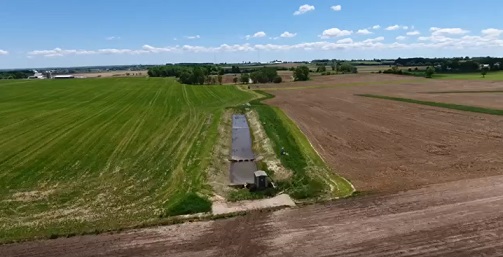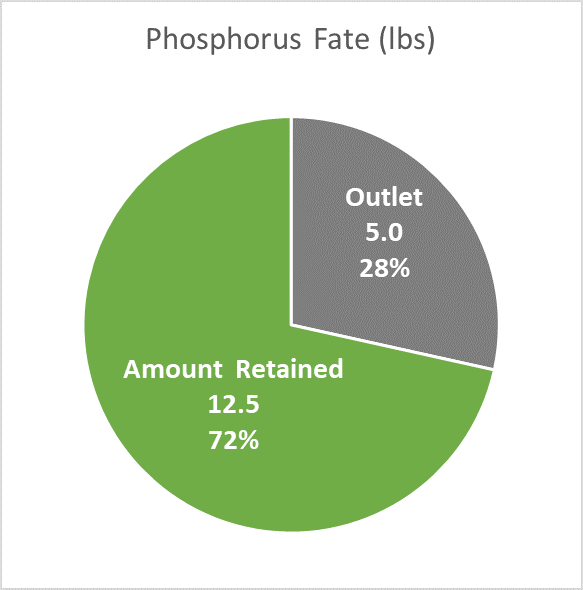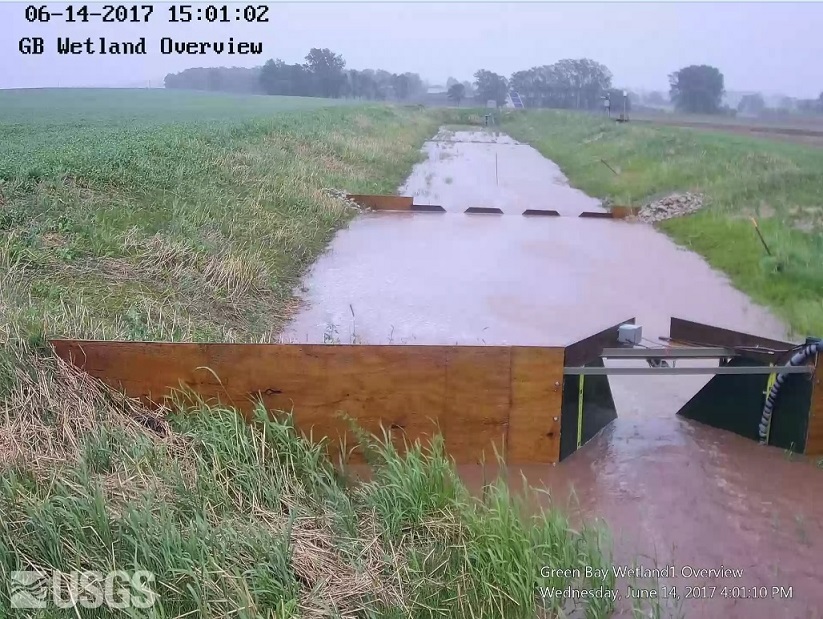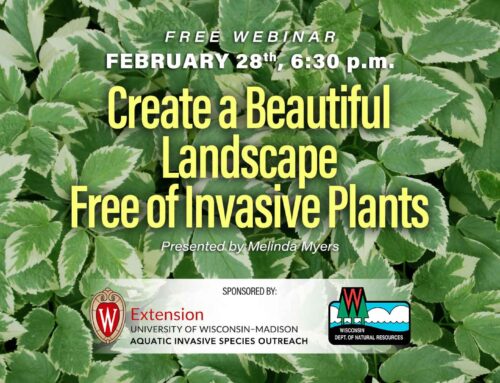
This treatment wetland, on the edge of a farm field near Kaukauna, WI, was constructed in 2017 in an effort to reduce sediment and phosphorus from entering West Plum Creek.
To improve water quality in the Lower Fox River watershed, a group of partners are working together to design, construct and test edge of field treatment wetlands during the next several years. The treatment wetlands act as natural filters – they are designed and installed to capture sediment and phosphorus before those pollutants enter tributaries that flow to the Fox River. Excess sediment and phosphorus are causing poor water quality in the Fox River and Green Bay.
As part of the Fox-Wolf Watershed Alliance Great Lakes Restoration Initiative Grant project, a new treatment wetland was designed and installed on farmland along West Plum Creek near Kaukauna in August of 2016. This project was supported by a cooperative landowner, The Nature Conservancy, the Outagamie County Land Conservation Department, the University of Wisconsin-Green Bay (UWGB), and the U.S. Geological Survey (USGS). The wetland is half an acre in size, comprised of a deeper basin to collect and have sediment settle at the bottom and two shallower wetland areas where plants absorb or trap soil and nutrients and hold them in place. The treatment system captures surface runoff and tile drainage water from 10 acres of agricultural lands.
USGS, UW-Green Bay and the Conservancy have developed extensive monitoring protocols to understand the wetland’s contribution to sediment and nutrient reduction. The first year of water quality data is encouraging.
Based on water measurements, the treatment system retained 87% of the sediment (8.5 tons) and 72% of the total phosphorus (12.5 pounds) between November 2016-September 2017. Of the 28% of phosphorus that was not captured, about half (2.5 pounds) was released from the system in the form of dissolved phosphorus. Partners are interested to see if the wetland can capture and immobilize more phosphorus, especially dissolved phosphorus, as plants become more densely established and cover more area.
A closeup of picture of the treatment wetland shows the deeper settling area (forefront) and the two shallower treatment areas in series.


Approximately 12.5 pounds of the 17.5 pounds of phosphorus that entered the wetland treatment system from the farm field was retained (source USGS, provisional).
“The wetland system trapped about a dump truck full of topsoil in the first 10 months of operation,” said Paul Reneau, hydrologist with the U.S. Geological Survey. “About half a dump truck was stored during a single storm on June 14 that dropped 3.4 inches of rain.”
In addition to improving water quality, another benefit of the wetland is added habitat for wildlife. While not designed as wildlife habitat, several species of animals have found the site and are utilizing it for breeding and foraging. Two species of frogs (green and leopard), several species of dragonflies, damselflies, aquatic macroinvertebrates and even one fish (fathead minnow) has colonized the site.
The goal of the pilot project is to better understand the ability of treatment wetlands to manage nutrients and soil in this watershed, which is largely dominated by agriculture. A similar treatment wetland, which is about an acre in size, was constructed in 2017 and is also being monitored. Data from these first wetlands will help to improve the design of future treatment wetlands in the watershed.
If the data continues to show that treatment wetlands are an effective way to reduce soil and nutrient transport to streams, the organizations involved hope to work with county conservation staff to share the information with landowners through personal visits, tours, and other outreach events.
“In addition to cover crops, we hope that treatment wetlands will be another strategy landowners can use to keep soil and nutrient pollution out of our streams, river and Bay,” said Nicole Van Helden, The Nature Conservancy’s Conservation Director for the Green Bay Watershed. “If so, the next step is getting the word out to generate interest and give landowners enough confidence to consider installing a treatment wetland on their land.”
This image, taken in October of 2018, shows the wetland plants that have taken over the treatment wetland. These plants help to settle sediment out of stormwater and will also uptake phosphorus which is a leading contributor to harmful algal blooms in the Lower Fox River and bay of Green Bay.







Article written by The Nature Conservancy
Questions? Contact Chad VandenLangenberg
Lower Fox River Projects Coordinator
Fox-Wolf Watershed Alliance
chad@fwwa.org



This sounds incredibly promising. I am curious how the minnows ended up in the wetland. Fascinating though and exciting!